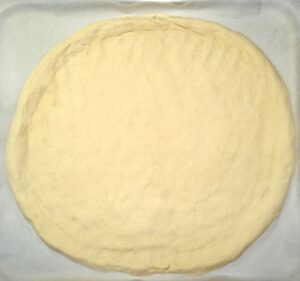California Pizza Kitchen Basic Pizza Dough Recipe
California Pizza Kitchen Basic Pizza Dough is a versatile, easy-to-make dough recipe that yields a deliciously crisp yet chewy crust perfect for homemade pizzas. Make our California Pizza Kitchen Basic Pizza Dough Recipe at home. With our Secret Restaurant Recipe your Basic Pizza Dough will taste just like California Pizza Kitchen.
Yield: 2 9-inch Pizzas
Ingredients
- 1 teaspoon Yeast
- 1/2 cup + 1 tablespoon Warm Water, between 105 and 110°F (In cold water the yeast will not activate and water over 120°F will kill the yeast and prevent the dough from rising.)
- 1 1/2 cups Bread Flour or All-Purpose Flour
- 2 teaspoons granulated Sugar
- 1 teaspoon Salt
- 1 tablespoon Extra Virgin Olive Oil + 1 tablespoon for coating
Instructions
To Make the Dough
- Place yeast in the warm water. Stir lightly to dissolve. Set aside for 5 to 10 minutes.
- If using an Upright Electric Mixer, like a KitchenAid, attach the mixing paddle since the dough hook isn’t effective for this small batch.
- Place all other ingredients, except 1 teaspoon olive oil, in mixing bowl. Add dissolved yeast/water. (Avoid pouring the salt directly into the yeast water as it can kill some of the yeast.)
- Mix gradually on the lowest 2 speeds for 2 to 3 minutes until the dough is smooth and elastic. Over-mixing can make the dough tough and cause it to rise too quickly due to friction.
- If using a Food Processor, use the plastic dough blade instead of the sharp steel knife to avoid cutting the gluten strands. Follow the same steps as above, but be cautious not to mix too long as the heat from friction can exceed 120°F and kill the yeast. Mix just until a smooth dough ball forms.
- If Mixing by Hand, place dry ingredients in a 4 to 6 quart mixing bowl. Make a well in the middle and pour in the liquids (except the teaspoon of olive oil). Use a wooden spoon to combine. After initial mixing, lightly oil your hands and knead the dough for 5 minutes until it’s slightly tacky, just beyond sticking to your hands.
- Lightly oil the dough ball and a 1-quart glass bowl. Place the dough in the bowl. Seal tightly with clear food wrap. Set aside on the counter and let it rise at room temperature (70-75°F) until doubled in bulk, about 1 1/2 to 2 hours. For the best texture and flavor, punch down the dough, reform into a ball, and refrigerate overnight, covered airtight. About 2 hours before making your pizza, remove the dough from the fridge.
- Divide dough into 2 equal portions, or 4 for smaller pizzas. Roll the dough into balls, ensuring any holes are sealed by pinching or rolling.
- Place the balls in a glass casserole dish with space to double in size. Cover with clear food wrap and let rise at room temperature for about 2 hours until smooth and puffy.
To Stretch and Form the Dough for Pizza
- Sprinkle a medium dusting of flour over a 12 x 12-inch clean surface. Use a spatula or dough scraper to carefully remove a dough ball, preserving its shape. Flour the dough liberally and place it on the floured surface.
- Press the dough down to form a flat circle about 1/2-inch thick. Pinch around the edge to form a lip or rim about 1/4-inch high. Continue stretching until you have a 9-inch diameter pizza dough.
To Dress the Pizza
- Lightly sprinkle cornmeal, semolina, or flour over a wooden pizza peel. Arrange the stretched dough on the peel and quickly add your sauces and toppings to prevent the dough from becoming soggy.
- To transfer to a preheated pizza stone, jiggle the peel to ensure the pizza moves freely. If it sticks, lift the edges and add more flour underneath.
- Slide the pizza onto the stone by positioning the peel over the stone, about 2/3 from the front, and jiggle and tilt to start sliding off. Pull the peel out quickly once the pizza begins to touch the stone. Let the pizza set for about 3 minutes before moving or removing it with the peel.
California Pizza Kitchen Basic Pizza Dough
A California Pizza Kitchen Copycat Recipe
To See ALL of Our California Pizza Kitchen Copycat Recipes - Click HERE To See ALL of Our Pizza Copycat Recipes - Click HERE To See ALL of Our Pizza Restaurant Copycat Recipes - Click HEREFollow Us to Get ALL of Our Latest Recipes
.

 Facebook
Facebook Pinterest
Pinterest